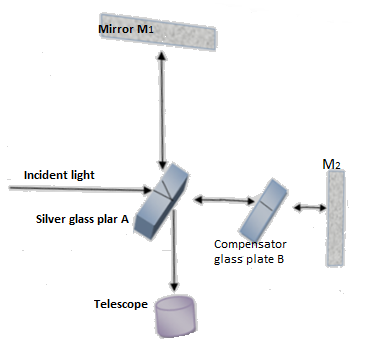Question 8: Describe construction and working of Michelson’s Interferometer. How one can determine the wavelength of light by using this instrument?
ANSWER
Michelson’s Interferometer is an optical instrument used to study the interference of light waves and its wavelength. Division of amplitude by partial reflection and partial transmission at the boundary of two mediums is the principle used.
Construction and working

There are two mirrors M1 and M2 and two glass plates A and B arranged as shown in the diagram. Plate A is slightly silvered. Thus when light falls on it, a part of it is reflected and a part is transmitted. Mirror M2 is movable and M1 is fixed. Monochromatic beam of light is directed to incident on the slightly silvered plate A. Here it is split in two parts; one is reflected towards mirror M1and the other transmits through the plate B and moves towards M2.
The first part reflects from mirror M1, transmits through plate A and enters the eye through the telescope. The second part reflects from M2, reaches to plate A again. Here it is reflected (from plate A) and go straight to the telescope and subsequently, eye.
Now the two reflected rays which enter the telescope are phase coherent because they are parts of the same beam. Therefore, an interference effect will be observed by the eye. Bright and dark fringes will be observed for constructive and destructive interference, respectively. Constructive interference will take place if the conditions for constructive interference are met and similarly, destructive interference will be observed when the conditions for destructive interference are there.
The condition for constructive interference is when;
Path difference = d = mλ
And the condition for destructive interference is when;
Path difference = d = (m+1/2) λ
for m = 1, 2, 3,…….
Path difference, d, is controlled by M2 which is mounted on a carriage which can move with the help of a micrometer screw.

Pingback:plane-polarized-light – msa
Pingback:diffraction-grating – msa
Pingback:Comprehensive Questions, Physical Optics … msa – msa
Pingback:Physical Optics, Comprehensive Questions … msa – msa
Pingback:index-cq-ch9-p11